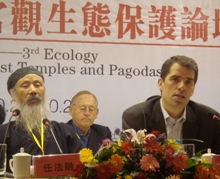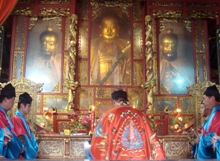Daoism—the way forward on climate change? By Olav Kjorven, Deputy head of UNDP
November 5 2008:
 |
 |
 |
Olav Kjorven, pictured with Old Master Ren of Louguantai, at the Third Daoist Ecology Protection Forum in China. |
By Olav Kjorven, Assistant Secretary General and Director of Development Policy at the UN Development Program
Last week something unprecedented happened in China. It may not have been as glitzy spectacular as the Olympics in Beijing over the summer. It did not attract heads of state or world celebrities. But could it possibly leave a more lasting imprint on the future of China and indeed the world?
What happened was that Daoist masters from all over China gathered near the ancient capital of Nanjing to agree on a seven-year plan for climate change action. Anybody with minimal knowledge of China will immediately understand that this is more than a curiosity. At the very least, it’s highly interesting. A national religious conference of any kind in this formally communist society demands some attention. But the fact that it was the ancient, homegrown Daoist tradition that gathered their most revered teachers to discuss what climate change means for them and their country is more than exotic, whether one looks at it from a religious, an environmental or a political perspective.
But how can a gathering of Daoist monks and nuns be potentially transformative in a country like China? This is after all a country where relentless, carbon-fueled economic expansion and consumerism seem akin to doctrine, and deeply embedded into the very fabric of society . In this respect Western societies are not that different, just a bit further along the same path.
And the Daoists, aren’t they rather the somewhat aloof bystanders to all of this, skeptically watching the world changing around them from their mountaintop temples while offering their brand of consolation and guidance to those who still seek it? Wouldn’t you have to be something of a really believing Daoist yourself, or a wildly optimistic and credulous climate warrior—or both, which probably would qualify as “religulous” in the eyes of Bill Maher—in order to believe that such a meeting could amount to much?
Possibly, but I am willing to accept the risk.
Let me try to explain:
First, the Chinese Daoists have been around for thousands of years. They have seen countless dynasties come, and go. But the Dao (or “the Way”) has outlasted them all, proving its resilience and strength. Daoist values and beliefs continue to hold enormous sway in Chinese society.
 |
 |
 |
Daoist monks take part in a ceremony at the Mao Shan Temple. |
Secondly, these values and beliefs are now welcomed back into the broader discourse of society, on matters such as economic, social and environmental policy. Daoism is no longer confined to the personal and family levels, and to festivals and rituals. Daoist temples and their masters are increasingly addressing politicians and business leaders at all levels about environmental and other challenges. This week’s gathering was actively attended by government officials. In their statements, they asked the Daoists for help in building a more environmentally harmonious and sustainable China. They had come to realize that in order to solve current challenges and secure a sustainable future, they indeed needed to mobilize all of society. Today, this includes religion, and not just the Daoists.
Third, and what makes this doubly interesting, Daoism probably has more on offer to the environmental cause in today’s China than any other major, organized religion. This is a strong statement, but anyone who has read key Daoist masters such as Lao Zi and Chuang Tsu knows to what extent this faith tradition emphasizes environmental stewardship as a sacred duty, something we simply must do in order to preserve our future and the balance of the entire world. Take climate change. The whole problem and challenge can be beautifully captured and explained through the concepts of Yin and Yang: The carbon balance between earth and sky is off kilter. This causes instability and disasters. It is truly significant that the current masters of Daoism in China have started to communicate precisely through this ancient yet new vocabulary.
Fourth, the Daoists are walking the talk. Over the last year or so they have installed solar panels on half of their thousands of temples around China and the job will be completed soon for all their sacred places. They are providing comprehensive guidance on all aspects of environmental and climate stewardship: water and land management, protection of biological diversity, energy efficiency of buildings, educational curricula, moral teachings, outreach through media and advocacy to business, etc. They will use a new Eight-Year Plan for Generational Change to make a holistic and systematic contribution to climate responsibility and environmental stewardship in China. The perspective goes beyond eight years. The ambition is to change the course for generations to come. Because the Daoists plan to be around for quite a while longer, continuing their sacred cosmic dances that transcend time and space.
Could this be the kind of stuff that in the end will tip the scales in favor of decisive climate action in China and beyond? Well, even if you’re half-way convinced by the four points above, you’d probably still think that’s a tall order to place on the Daoists—and I would agree. The good news, however, is that similar things are now happening in all the 11 major religions in our world today. They are all coming up with multi-year plans for climate action, spanning all dimensions of who they are and what they do. They are greening their management of land, buildings and financial investments. They are articulating care for creation more strongly and clearly in their teaching and preaching. They are strengthening their climate advocacy towards society at large, but grounded in their own spiritual and moral traditions.
By November next year, a few weeks before the crucial Copenhagen climate meeting takes place, these faiths will all present to the world their plans and commitments. This is no small contribution—these 11 faiths represent in some way or another roughly 80-85 percent of humanity. Perhaps that’s enough to bring us to a global, political tipping point? Perhaps that’s enough to convince even the most stubborn and reluctant of policy makers that the time to secure humanity’s future is now?
This article was originally written as part of the UN Dispatch series for the UN website. Olav Kjorven was a key speaker at the Daoist Ecology Conference, and appeared as a guest of ARC, which was a co-organiser.
Links*** Link here for Olav Kjorven's speech at the Third Daoist Ecology Forum in Jurong.
*** Link here for the Chinese Daoists' draft Ecology Protection Eight Year Plan.
*** Link here to learn more about the ARC/UN/Faiths Seven Year Plan Programme.
*** Link here for the latest news from around the world of faiths taking up Seven - or Eight - Year Plans.
*** Link here for more details about the Third Daoist Ecology Conference at Jurong.
And
here for the Mao Shan Declaration - in Chinese and English.
*** Link here for details of Martin Palmer's introductory talk at the Daoist Ecology Forum in Jurong.
*** Link here for ARC's response to the Daoist Ecology Forum in Jurong.
*** Link here to download the latest guidelines document to the full Seven Year Plan. (Note this is a file of 2MB)
*** Link here for more Daoist eco-news.
|

